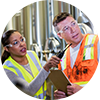More OSHA Inspections Possible in 2022
In this webinar, you will learn about:
- Review of OSHA inspection trends from the last five years
- 2022 OSHA outlook: what’s changing
- Three occupational health strategies for meeting OSHA standards
- How to protect employees and your business
Presented by:
Deepa Rajakrishnan, MD, MBA
Director of Medical Operations
Jim Waugh, PT, MPT
Director of Therapy Operations
Opening
0:00-1:18
Hello everyone, and welcome to the Concentra® Webinar, Get Ready! More OSHA Inspections Possible in 2022. Today's webinar will be presented by Dr. Deepa and Jim Waugh.
Dr. Deepa is the director of medical operations in North Texas, overseeing more than 30 clinicians to ensure quality care at Concentra medical centers.
Jim Waugh is a Concentra director of physical therapy, with more than 15 years of experience in providing physical therapy in an occupational health setting. He is a member of the Workers' Compensation Research Institute’s Texas Advisory Committee.
At the conclusion of the presentation, we will have a 10-to-15-minute Q-and-A session with Dr. Deepa and Jim. You can submit your questions throughout the presentation to be answered during the Q-and-A. They will answer as many questions as possible within the time allowed. I encourage you to submit your questions, even if there are some that cannot be answered during the Q-and-A. Your questions give us ideas for future webinars, articles, and other content that you may find valuable.
A recording of the webinar and a copy of the slides will be e-mailed to you after the presentation. You can view it again at your convenience.
Dr. Deepa, Jim, we're ready to begin.
Agenda
1:19-1:51
Thank you.
Today we're going to cover OSHA inspection trends from 2015 through 2020. We're going to look at the anticipated changes for 2022, and we're going to highlight three strategies for limiting the impact of an OSHA inspection, which will include an injury prevention approach, building a safety reputation, and occupational medical director oversight.
OSHA Inspection Trends: 2015-2020
1:52-5:02
As we look at the trends here, we're first going to look at what is OSHA’s jurisdiction. The map you're viewing outlines OSHA's jurisdiction, which covers 7,000 work sites nationwide:
- 24 states fall under federal OSHA guidelines, which are the lightest blue.
- 26 states have OSHA approved state plans, which are the medium blue.
- And five have OSHA approved state plans which cover only government workers, which those are the darkest blue.
When we look at the inspections, this chart gives us total OSHA inspections for the years 2015 through 2020 when we consider the full column for each year. The orange field in each year represents programmed inspections. These are OSHA inspections that focus OSHA enforcement on industries and operations where hazards are known to exist, such as combustible dust, chemical processing, and falls in construction.
The blue field represents unprogrammed inspections. These are OSHA inspections triggered by employee complaints, injuries or fatalities, or referrals from compliance and health and safety officers or other health agencies.
We can draw some basic conclusions from this information. During this period, the total inspections have remained relatively consistent; with, of course, a noticeable dip in 2020 when they were just over 21,000 inspections compared to the range of about 32,000 to 35,000 in other years, which is likely due to COVID.
We can also see that there's a 2-to-3 relationship that is consistent from year to year between programmed inspections and unprogrammed inspections. So, in other words, two programmed inspections for known workplace hazards, there were also three workplace inspections that occurred on complaints based on someone, such as an employee, safety compliance officer, or someone outside of that agency. We can go to the next slide.
This slide highlights the top 10 OSHA penalties in 2019. They included:
- Employee died from a fall
- Willful electrical safety violations
- Exposure to air, thermal, electrical, or mechanical hazards
- Unsafe storage of merchandise and/or walkways and exit routes
- Willful violation of lockout and machine guarding
- Multiple safety hazards, lack of PPE, hearing and fall protection
- Lack of machine guarding, fall protection, and training
- Employee death due to poor scaffolding and fall protection
- Exposure to hazardous materials, failure to implement those requirements
- And failure to provide fall protection, training, and fire protection
And you can see on the right-hand side of the screen, the cost in dollars for each of those violations. And now I'm going to hand it over to Dr. Deepa.
OSHA Inspection Trends: 2015-2020
5:03-8:57
Thank you, Jim. Given the sheer number of worksites that OSHA has jurisdiction over, they need to prioritize how they do the inspections. The focus on the most hazardous worksites. This slide lists out all the priorities, how they decide what gets the attention.
The very first one is the imminent danger situations. These are hazards that could cause death or serious physical harm. Compliance officers will ask employers to correct these hazards immediately and/or remove endangered employees.
The second one is the severe injuries and illnesses. I think most of you know that all work-related fatalities must be reported within eight hours, then all work-related inpatient hospitalization, amputations, or loss of eye must be reported within 24 hours.
The third one is the employee complaints. These complaints receive a high priority response because a lot of those employees are encouraged to file their complaints anonymously and so these allegations of hazards or violations receive a high priority from OSHA.
The fourth one is the referral of hazards from other federal, state, and local agencies and organizations or even the media. These receive a consideration for inspection.
The fifth one is the targeted inspections. These inspections are aimed at specific high-hazard industries or individual workplaces that historically have experienced high rates of injuries and illnesses.
The sixth kind is follow-up inspections, and these check for any abatement of violations during previous inspections and they are also conducted during certain circumstance.
The seventh one is the lower-level priorities, and these are handled by phone or fax.
This is the priority order we have seen them use until now and we've grown used to seeing this. But as we will see later in this presentation, this may well be changing in 2022, along with the possible increase in the number of inspections. Next slide, please.
Let's look at what happens when an OSHA inspection occurs. First, OSHA researches the company history. They look through – who is the company? What is their history? What is their injury history? And they decide on inspection.
They present the credentials on-site. They hold an opening conference, and then they conduct the walk around and hold the closing conference. This is the first part of the inspection. Next slide, please.
Later, citations are proposed based on the analysis and this is done within six months. These penalties are categorized as willful, serious, other than serious, de minimis, failure to abate, and repeated penalties. The employer is allowed to appeal within 15 working days. So, this is what happens in the OSHA inspection. I'm going to hand it over to Jim for basic changes in 2022.
2022 Outlook: Anticipated Changes
8:58-10:42
In Fiscal Year (FY) 2019, OSHA's budget increased less than one percent over the previous year, and the next two years it increased by about four percent. In 2022, based on proposed figures, OSHA’s budget is expected to increase by 12.3 percent to $664 million. So, as you can imagine, with that big increase in budget, more inspections are anticipated. Next slide.
So, what's driving that? There are a lot of different things really associated with the new administration. You have aggressive use of citations and enforcement; expansion of the bad actor or egregious high-dollar cases; skepticism about employer safety incentive programs; and reduced use of cooperative programs and partnerships. Also, whistleblowers are being encouraged. There's a streamlined process for perceived violations, more recordkeeping, and increased publicity as deterrence.
Strategy #1: Multipronged Injury Prevention
10:43-20:02
So, as we move on, we want to look at some of the strategies that can help you reduce red flags that may trigger an OSHA inspection or hopefully prevent an OSHA fine.
The first one is injury prevention. Thirty percent of all work-related injuries are musculoskeletal in nature. The Survey of Occupational Illnesses and Injuries (SOII) collects data on musculoskeletal disorders for cases involving days away from work. In 2018, private sector injuries resulted in 900,380 days away from work. Of those, 272,780 days away from work were related to musculoskeletal injuries, or around 30 percent. That's a huge number.
The most common types of musculoskeletal disorders are sprains, strains, and tears, back injuries, and repetitive-use injuries. Cumulative trauma disorder, also known as CTDs, are a general term for a group of musculoskeletal disorders caused by repetitive movements that impact muscles, tendons, and nerves. OSHA consider CTDs the nation's most common occupational health problem and it has an estimated cost of $20 billion a year; that's billion with a B. So that's a significant number. Injury prevention can go a long way. Next slide, please.
Now we'll look at six musculoskeletal injury prevention measures. They are:
- Pre-employment functional testing
- Musculoskeletal screening
- Early reporting programs
- Pre- and intra-shift exercise programs
- Workplace ergonomic guidance
- On-site athletic trainer or physical therapist programs
Pre-employment functional testing is defined as quantifying employing capabilities to handle physical work tasks using a well-designed assessment format. Concentra conducts human performance evaluations, or HPEs, which are designed for specific jobs, based on objective measurements of the essential job functions. HPEs are used primarily for post-offer pre-employment assessments but they can also be used for post-injury return-to-work assessments. Next slide, please.
Musculoskeletal screening is designed as a proactive objective assessment of strength, flexibility, and balance that can be used for new hires and existing employees annually or episodically. Musculoskeletal screening can use a scoring system or a simple movement test to identify deficits that are then addressed in customized consultations. However, it is important to note that the potential employee cannot be excluded from a job based on a musculoskeletal screen since that screen is not based on the essential functions of the job.
Early symptom evaluation is a Concentra approach intended to avert serious injury by identifying early onset symptoms and addressing them at a first aid level of care. In this approach, it helps reduce injury costs, duration, and recordable injuries. It includes direct symptom evaluation, first-aid level of care and medical assessment. And it may include incident investigation, work rotation planning, and employee education.
Pre- or intra-shift exercise programs have been shown to be very effective in the workplace in reducing musculoskeletal disorders, which, as we mentioned earlier, were 30 percent of total injuries. It does so by lowering direct cost linked to healthcare expenses. It increases productivity in the workforce, reduces absenteeism, increases morale, and lowers the risk of diabetes, heart conditions, stroke, some cancers, and depression.
An example of this would be a study that was done with firefighters. A randomized control trial of firefighters examined the effectiveness of supervised or telehealth-delivered exercise programs in reducing lost work time related to low back pain.
Firefighters who received supervised instruction, either in person or via telehealth, were compared to a control group that was not in an exercise program. The exercise program for the supervised groups consisted of back and core exercises, two times a week for 12 months.
Worksite exercises reduced the loss work time due to low back pain for firefighters, regardless of the delivery method. The control group had 1.15 times more hours lost from work than the supervised group and 5.51 times more hours lost time than the telehealth group. The groups that were receiving the exercise programs, whether via either telehealth or in-person, were much less likely to have lost time or days away from work. Next slide please.
Workplace ergonomic guidance is the next strategy. Workplace ergonomic guidance can improve employee safety and improve upon the most common workplace contributors to musculoskeletal disorders. Those include extended sitting, extended standing, effects of vibration, chemical and heat effects, and poor lighting.
So, when we look at extended sitting it can cause weakened back muscles. It induces poor posture and poor muscle imbalance. When we look at the standing, standing requires 20 percent more energy, which can lead to strains in the legs, feet, and circulatory system. Some solutions for that would be to take breaks, use anti-fatigue mats, an anti-fatigue footwear.
Vibration is a big factor. It's associated with a lot of musculoskeletal disorders, in the hands, forearm, shoulder areas, as well as whole body. It also can contribute to awkward postures. Some solutions for that would be anti-vibration gloves, anti-vibration mats, job rotation. Those are all good quick fixes to try to reduce the effects of vibration on the musculoskeletal system.
Chemical and heat effects impact the neuromuscular and musculoskeletal systems and may reduce physical performance. Then, finally, poor lighting leads to visual discomfort, lethargy, back and neck and shoulder pain, decreased alertness, and a decline in work performance. There are a lot of different ergonomic lighting types that are out there, and you want to refer to them. Don’t just look at the quantity of the light, but also at illumination uniformity, luminance and distribution, color rendering and temperature, the nature of the light, which could be either artificial or natural, and glare from any of the lighting that might cause on some of the machines and things.
The sixth way to help prevent musculoskeletal injuries is using an on-site athletic trainer or a physical therapist. Leaving employees to implement best practices on their own is not well-supported by the research evidence. To be effective in reducing pain and preventing injuries, it is beneficial to have the presence of an on-site clinician, such as an on-site trainer or physical therapist.
What we've found and what the evidence shows, is that education isn't enough. You really need somebody on-site to spend time with employees to prevent injury. The benefits of having an athletic trainer or physical therapist on-site include:
- A deep understanding of the job requirements
- The ability to provide appropriate ergonomic modifications
- The ability to provide targeted interventions for employees
- Fewer treatments to achieve optimal outcomes
- No time loss for travel to on-site or off-site appointments – which saves the employee and the employer time and productivity
Now I will hand the presentation over to Dr. Deepa to cover the second strategy.
Strategy #2: Building a Safety Reputation
20:03-22:17
Thank you, Jim. Strategy #2 is building a safety reputation. If you remember, back in the discussion on OSHA inspections, OSHA focuses broadly on the company history – essentially your safety reputation. Repeated and/or willful violations and failure to abate identified issues put you in a harsher light with OSHA than a random injury that occurs despite the company’s dedication and vigilance in workplace safety.
By building this safety reputation over time, an employer may stay low on the OSHA radar.
Let's look at some strategies from an occupational health perspective to build an employee safety reputation.
First and foremost, a relationship with an occupational health provider is critical. It sounds basic, but it serves to enhance the health of your workforce and removes obstacles to medical care in multiple ways.
The second strategy is an occupational health expert-led inspection of workplace facilities to identify the health and safety red flags and to recommend mitigation measures.
The third strategy would be to have a sound, evidence-based occupational health practice that stays current on changes nationwide. For example, the use of a medical expert panel to create strategy.
The fourth one is an employee education program. It is key, not only in terms of knowledge, but also to improve compliance within the company employees for the health and safety policy.
Last, a nationwide network that is interconnected through a secure technology platform and an EMR (electronic medical recording) software is pretty important, too. Next slide, please.
Strategy #3: Occupational Medical Director Oversight
22:18-25:01
Strategy #3 is occupational medical director oversight of non-injury services. This offers many advantages for all employers, especially those who enlist the aid of a registered nurse or other medical professional.
First, occupational environments frequently involve exposures, whether it be physical, or chemical, or biological, and this may be regulated, and they are high on OSHA’s radar.
Occupational laboratory and medical tests can also influence workplace environment, job duties, health effects, and disability for the individual and general workforce. State allowances for testing without physician oversight generally pertain to general health but not occupational health and, as you know, the occupational health policies have very different reasoning. Physician oversight helps avoid unnecessary testing, increased cost, and inaccurate interpretation of test results. Next slide, please.
What does an occupational medical director do? Having an occupational medical director has all the advantages of a company medical director, but without the time and expense and the complications of hiring a permanent position. Next slide, please.
The occupational medical director fulfills a wide range of needs. They:
- Develop and review corporate health and safety program, the initiatives, and the plan
- Review employee wellness and preventive medicine programs
- Help with travel medicine
- Oversee the biological screening and vaccination programs, and provide medical review officer for substance abuse issue
- Provide chart reviews and medical determinations
- Help with medical surveillance and crisis response
- Consult on OSHA-mandated hazardous material programs and requirements
That concludes our presentation. Now we will open it up for Q&A.





